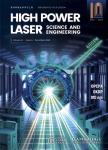Using the ROSS optical streak camera as a tool to understand laboratory experiments of laser-driven magnetized shock waves
Using the ROSS optical streak camera as a tool to understand laboratory experiments of laser-driven magnetized shock waves作者机构:Rice UniversityUSA University of Michigan-Ann ArborUSA Lawrence Livermore National LaboratoryUSA Awe PlcUK
出 版 物:《High Power Laser Science and Engineering》 (高功率激光科学与工程(英文版))
年 卷 期:2018年第6卷第2期
页 面:63-68页
核心收录:
基 金:the DOE NLUF program DE-FOA-0001568 the Data Analysis and Visualization Cyber Infrastructure program OCI-0959097
主 题:laser optical systems plasma astrophysics
摘 要:Supersonic flows with high Mach number are ubiquitous in astrophysics. High-powered lasers also have the ability to drive high Mach number, radiating shock waves in laboratory plasmas, and recent experiments along these lines have made it possible to recreate analogs of high Mach-number astrophysical flows under controlled conditions. Streak cameras such as the Rochester optical streak system(ROSS) are particularly helpful in diagnosing such experiments,because they acquire spatially resolved measurements of the radiating gas continuously over a large time interval,making it easy to observe how any shock waves and ablation fronts present in the system evolve with time. This paper summarizes new ROSS observations of a laboratory analog of the collision of a stellar wind with an ablating planetary atmosphere embedded within a magnetosphere. We find good agreement between the observed ROSS data and numerical models obtained with the FLASH code, but only when the effects of optical depth are properly taken into account.



